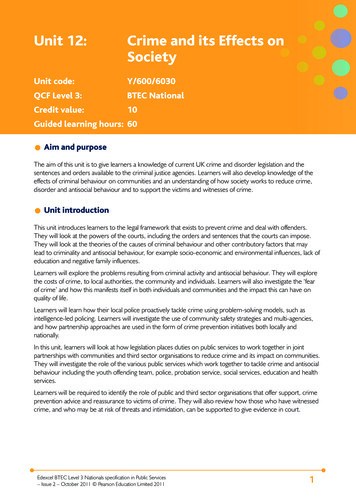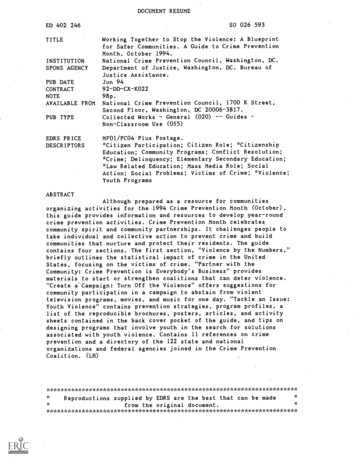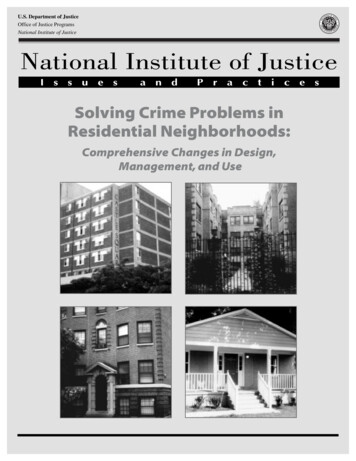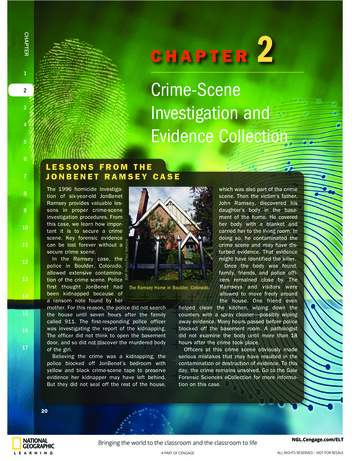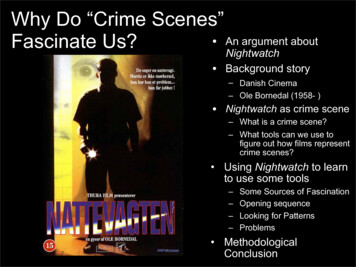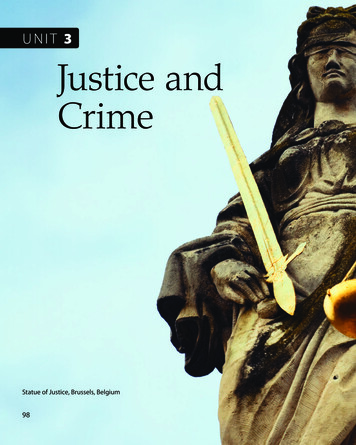
Transcription
Unit 3Justice andCrimeStatue of Justice, Brussels, Belgium98
1. According to the laws in the United States,“Justice is blind.” What does this sentencemean?2. Movies, TV shows, and books about crimesand criminals are very popular. Why do youthink people are interested in these typesof stories?3. People often say that the punishmentshould fit the crime. What is the properpunishment for robbing a bank, for stealinga car, or for murder?99
CHAPTER7 Solving Crimes with Modern TechnologyA forensic scientist dustinga window for evidencePrereading1. Work in a small group. What types of technology can help solve crimes? Make a list in thechart below. When you are finished, share your list with the class.Type of TechnologyHow can this help solve a crime?2. Who are the different people that solve crimes? How are their jobs different from eachother? How do they try to solve crimes?100Unit 3Justice and Crime
ReadingRead the passage carefully. Then complete the exercises that follow.CD 1TR 8Solving Crimes with Modern 52627282930313233Solving crimes is one of the most important jobs of law enforcement. Improvements incrime technology help investigators identify suspects and solve crimes faster and moreefficiently. Detectives even use this technology today to solve crimes from a long time ago.A well-known example of new technology is DNA testing. Previously, when policefound body fluids such as blood, sweat, and saliva at a crime scene, they collectedit as evidence. However, this evidence could not be analyzed at that time. Even so,crime experts stored it in a freezer. Today, modern DNA testing helps experts analyzethis type of evidence to solve recent crimes. They are reinvestigating “cold cases,” too.Cold cases are unsolved crimes from the past. Now criminologists have the moderntechnology they require to analyze frozen evidence. In many cases, they identifysuspects with the information they get from it.The murder of ten-year-old Anna Palmer is an example of a cold case. In 1998,someone attacked and killed Anna outside her house in Salt Lake City, Utah. Therewere no witnesses to the murder and very little evidence. Then in 2009, this cold casewas reopened. Experts examined dirt from under Anna’s fingernails and found DNAevidence. This DNA matched the DNA of Matthew Brock. In 2011, Brock pled guiltyto Anna’s murder and is now in prison for life.Another example of modern technology involves new kinds of fingerprint testing.In the past, analysts could only examine fingerprint patterns and check them with theones they had on file. The fingerprints of convicted criminals are kept permanentlyon file in police records. People whose fingerprints are not on file cannot be identifiedin this way. Today, however, fingerprint testing provides additional information,such as the age and sex of its owner. The fingerprints also reveal if the person takesmedication. Investigators can use this new technology to reanalyze fingerprints fromcold cases to help identify a suspect and even solve the crime.In one case, the police in Tacoma, Washington, found the body of a 27-year-oldwoman who had been murdered in her bedroom. There were no witnesses, and herapartment had few clues. The only real evidence did not seem very helpful. Thevictim’s bed sheet had some of her blood on it and looked as if someone had wipedhis or her hands. At the time of the murder, it was impossible to identify a fingerprint,or even a palm print, from fabric. The detectives could not use the evidence, but theysaved it. They called Eric Berg, a forensic expert with the Tacoma police, for help.A forensic expert is a person who helps solve crimes.Chapter 7Solving Crimes with Modern Technology101
343536373839404142434445Eric Berg is not only a forensic expert, but a computer expert, too. He developedcomputer software to enhance, or improve, crime scene photos. He used his softwareand reexamined the fabric from the murder case. It worked! Eric Berg used his softwareto make the palm print more apparent, or clear. Then he gave the new evidence to thedetectives. The detectives checked the palm print with clear palm prints they had onfile. They identified a man whose palm print matched a print on file and arrested him.The court eventually convicted him of the crime, and he is now in jail. Today, manyother police departments have reopened old cases and are using Eric Berg’s software.Police are developing other kinds of new crime-solving technology that areenabling them to reconsider evidence they could not use in the past. By helping thepolice identify suspects, new technology may help solve cold cases as well as currentcases and put more criminals in prison.A forensic scientist securing a fingerprint102Unit 3Justice and Crime
Fact FindingRead the passage again. Then read the following statements. Check ( ) whether each statementis True or False. If a statement is false, rewrite it so that it is true. Then go back to the passageand find the line that supports your answer.1.TrueFalseFingerprint testing always helps to solve crimes.2.TrueFalseModern fingerprint technology can identify body fluids.3.TrueFalse When a woman was murdered in Tacoma, Washington, it wasimpossible to identify a fingerprint from fabric.4.TrueFalseEric Berg developed new software to improve photos.5.TrueFalseEric Berg’s technology may help solve older crimes, too.6.TrueFalse In the past, detectives never took samples of evidence at acrime scene.7.TrueFalseDetectives can always solve cold cases with new technology.Reading AnalysisRead each question carefully. Circle the letter or the number of the correct answer, or write youranswer in the space provided.1. Read lines 1–3. Law enforcement meansa. making sure people obey the law.b. writing laws to solve crimes.c. creating new technology.Chapter 7Solving Crimes with Modern Technology103
2. Read lines 4–8.a. Previously means1. unfortunately.2. in the past.3. surprisingly.b. What are blood, sweat, and saliva?c. How do you know?d. A crime scene is1. the place where the crime occurred.2. the evidence of a crime.3. a collection of body fluids.e. In the past, what did the police sometimes do with evidence they could not identify?1. They threw it away.2. They didn’t collect it.3. They saved it.f. Analyze means1. inspect carefully.2. collect.3. store.3. Read line 9. Cold cases area. crimes that were committed in the winter.b. old crimes that have not been solved.c. recent cases that are unsolvable.4. Read lines 15–16. This DNA matched the DNA of Matthew Brock.a. This sentence means1. the DNA was Matthew Brock’s.2. the DNA was the only evidence of the crime.3. the DNA was different from Matthew Brock’s DNA.b. Matched means1. was different from.2. was the same as.3. was similar to.5. Read lines 20–21. Whose prints are already on file?a. People who have never committed a crime in the pastb. People who have been convicted of a crime in the pastc. All the people who live in a city, state, or country104Unit 3 Justice and Crime
6. Read lines 27–30.a. Which word is a synonym for clues?b. A victim is1. the person who commits a crime.2. the person who is harmed by a crime.7. Read lines 30–33.a. What is a type of fabric?1. A bed sheet2. A fingerprint3. Bloodb. What was the only evidence the Tacoma police had?c. An expert is a person who1. is very skilled at working with evidence.2. is very skilled at working with computers.3. is very skilled at working in a special field.d. What is a forensic expert?8. Read lines 34–37.a. Software refers to1. computers.2. computer programs.3. photos.b. Enhance meansc. How do you know?.d. A synonym for apparent is1. new.2. clear.3. evidence.9. Read lines 42–43.a. Enabling means1. allowing.2. making.3. telling.Chapter 7Solving Crimes with Modern Technology105
b. Reconsider means1. solve quickly.2. think over again.3. get rid of.10. What is the main idea of the passage?a. New technology always solves every crime, even old ones.b. New technology helps solve many crimes, even old ones.c. New technology is only useful in solving murders.Vocabulary SkillsPART 1Recognizing Word FormsIn English, there are several ways that verbs change to nouns. Some verbs become nouns byadding the suffix –ment, for example, arrange (v.), arrangement (n.).Complete each sentence with the correct word form on the left. Use the correct form of the verb.The nouns may be singular or plural.improve (v.)improvement (n.)enhance (v.)enhancement (n.)enforce (v.)1. Criminologists have made many2. Eric Berg’s softwarerequirement (n.)106to identify evidence. A police officer not onlythe law, but also tries to help prevent crimes from happening.4. Eric Bergdevelopment (n.)require (v.)crime scene photos. Criminologists use3. One of a police officer’s jobs is lawenforcement (n.)develop (v.)the ability of the police to catchcrimes. New technologycriminals.thesein the ways they now solvecomputer software to help solve crimes. Theof new software programs is helpful to forensic experts.5. Forensic experts sometimesmodern technology to identifysuspects in a crime. However, thiswhen there are several witnesses to the crime.Unit 3 Justice and Crimeis not always necessary
PART 2The Prefix reIn English, the prefix re- means again. It can be added to many words, especially verbs, for example,rewrite means write again when the prefix re- is added to write.Read the following sentences. Complete each sentence with the correct word from the box. Useeach word only en1. Unsolved murder cases are never really closed. The police willa caseand try to find the murderer if new evidence becomes available.2. The police have started toa 20-year-old murder case. They think theycan solve it now.3. Improved fingerprint testing enables experts tofingerprints for moreinformation, such as the age and sex of the owner.4. Investigators are going toopening several old unsolved cases. However,they are not sure they have enough evidence.5. In the past, investigators could get only a little information from blood, such as bloodtype. Now they canblood for much more information that will helpthem identify a crime suspect.Chapter 7Solving Crimes with Modern Technology107
Vocabulary in ContextRead the following sentences. Complete each sentence with the correct word or phrasefrom the box. Use each word or phrase only once.arrest (v.)clues (n.)convict (v.)pattern (n.)reopen (v.)scene (n.)criminologists (n.)enforce (v.)evidence (n.)1. Police officers, detectives, and many other peoplethe law in a varietyof ways.2. Muchis required in order to identify a suspect and solve a crime.3. Today, investigators frequentlycold cases because they can reexaminestored evidence for new information., such as hair and skin, provide very good evidence for identifying crime4.suspects.5. Sometimes police can match theof a car tire from a crime scene witha design from the tire manufacturer.6. Only police investigators are permitted at the7. Courts cannotof a crime.a person without sufficient evidence to prove the person is guilty.are very skilled at solving crimes.8.9. The police can onlysomeone when they have enough evidence to suspectthat person of having committed a crime.Reading SkillUnderstanding Line GraphsLine graphs often contain important information. It’s important to understand them. Linegraphs compare numbers or amounts, and give you information about the reading.Read the line graphs. Then answer the questions.108Unit 3 Justice and Crime
Homicide Offenders by Age and Genderin the United States in One Year40003635Number of 5000female162513 012 8550–59Homicides by Age Group60–691031070 andoverSource: http://www.fbi.gov1. Who is an offender?a. The victimb. The killer2. What gender and age group committed the most murders in this one-year period?a.b.c.d.Males between 13 and 19Females between 13 and 19Males between 20 and 29Females between 20 and 293. What gender and age group committed the fewest murders in this one-year period?a.b.c.d.Males under 12Females under 12Males over 70Females over 704. What can we conclude from this graph? Check ( ) all that apply.a. As people get older, they are more likely to commit homicide.b. At any age, more males than females commit homicide.c. The very young and those over 70 are the least likely to commit homicide.d. Females and males are equally likely to commit homicide.e. Males between 20 and 29 years of age commit more murders than females of allages combined.f. Even children commit murder.Chapter 7Solving Crimes with Modern Technology109
Homicide Victims by Age and Genderin the United States in One Year40003703Number of Homicide 000500068233958256037725933331112 7560–69Homicide Victims by Age Group19970 andoverSource: s/12s0311.pdf1. Who is a homicide victim?a. The person who is killedb. The killer2. Who is least likely to be a victim of a murder?a. A male aged 70 or olderb. A female under 12 years of agec. A female between 60 and 69 years old3. What can we conclude from this graph? Check ( ) all that apply.a. Children under 12 are the least likely to be murdered.b. Older people are the least likely to be murdered.c. More males between 20 and 29 years old are murdered than any other group.d. The very young and those over 70 are the least likely to be murdered.e. At any age, more females than males are murdered.f. More males between 20 and 29 years of age are murdered than all females ofevery age combined.110Unit 3 Justice and Crime
Information RecallRead the passage again, and review the information in the line graphs. Then answerthe questions.1. How is fingerprint testing today more helpful than it was in the past? 2. How are investigators able to solve cold cases that were unsolvable in the past? 3.Who is most likely to be both a homicide offender and a homicide victim? Writing a SummaryA summary is a short paragraph that provides the most important information from a reading. Itusually does not include details, just the main ideas. When you write a summary, it is importantto use your own words, and not copy directly from the reading.Write a brief summary of the passage. The summary should not be more than four sentences.Use your own words. Chapter 7Solving Crimes with Modern Technology111
Topics for Discussion and Writing1. In the United States, the fingerprints of convicted criminals are kept on file permanently. Do youagree with this policy? Or do you think the fingerprints should not be on file after the criminalcomes out of jail? Why? Explain your opinion.2. Criminal investigators try to collect as much evidence as they can in order to identify the person whocommitted a crime. How much evidence does a jury need in order to convict a person of a crime?3. Many people’s fingerprints are not on file. As a result, fingerprints from a crime scene may not helpcriminal investigators find the criminal. Should the law require all people to put their fingerprintson file even if they have never committed a crime? Explain your reasons for your answer.4. Look at the DNA samples below.a. Which suspect’s DNA is the best match for the DNA sample found at a crime scene?b. Does this DNA match prove that this suspect committed the crime? Why or why not?CrimeSceneDNA Samples From:SuspectSuspect#1#2Suspect#3Source: 01 crime5. Write in your journal. Chapter 7 discusses some new kinds of technology to help solve crimes.Which new technology do you think is the most important one? Why? What types of crimes do youthink it can help solve?112Unit 3 Justice and Crime
Critical Thinking1. Each person’s fingerprints are unique and do not change over the person’s lifetime. Scientistsstudied fingerprint patterns and developed a system for classifying them by type in order to makeidentification more accurate. Examine the sample fingerprints below.Figure 1: ArchFigure 2: Left loopFigure 3: Right loopFigure 4: TentFigure 5: WhorlSource: National Institute of Standards and TechnologyOn a separate sheet of paper, using an ink pad, make your own fingerprint and compare it to thesamples. Which pattern does your fingerprint have? How is it similar to that pattern? What are thedifferences that make it clear they are not the same fingerprint? When you have finished, be sureto destroy the paper with your fingerprint on it.2. Go online to a search engine such as Google to find a website with sample fingerprintsand fingerprint-matching games. Use these key words: “classifying fingerprints” or “fingerprintsamples and how to classify them.” Examine the sample prints. Then do a fingerprint-matchinggame. See if you can identify the print taken from a crime scene.3. Eric Berg used his own time and money to improve crime scene photos. Why do you thinkhe worked so hard at this? What might be some reasons? Compare your answers with thoseof your classmates.Chapter 7Solving Crimes with Modern Technology113
Crossword PuzzleReview the words in the box below. Then read the clues on the next page. Write the words in thecorrect spaces in the 4151617114Unit 3 Justice and Crime
Crossword Puzzle CluesACROSS CLUES2. Manyhelp the police solve crimes. Some work with computers; others work withphotography, for example.is a type of body fluid.7.8. The job of the police is law. They try to make sure that laws are obeyed.10. New ways of crime solvinginvestigators to solve many crimes.12. Sometimes a piece of, such as material from a coat, becomes important evidencein a crime.13. The man’s guilt was, or clear, from the evidence, so the man pled guilty to the murder.14. Investigators oftenold murder cases because they can use evidence that was notuseful in the past.16., police could only look at the design of fingerprints. Today, they can get much moreinformation from fingerprints.are evidence that police find and collect at the scene of a crime.17.DOWN CLUES1. Modern, such as powerful computers and improved photography, help policeidentify suspects.3. The4. There are manyof every person’s fingerprints is unique. No one has exactly the same fingerprints.crimes that investigators hope to find answers to one day.5. Eric Berg often provides useful6. Experts carefullyevidence to police after he studies it.fingerprints, body fluids, material, and other evidence from every crime.9. Some computer programs canan image so it can be used as evidence in a crime case.11. Every person’s DNA is unique. When police find abetween a suspect and DNA froma crime scene, they are confident that the person may be guilty.15. Theof a crime is the place where the crime took place.Chapter 7Solving Crimes with Modern Technology115
True False Modern fingerprint technology can identify body fluids. 3. True False When a woman was murdered in Tacoma, Washington, it was impossible to identify a fingerprint from fabric. 4. True False Eric Berg developed new software to improve photos. 5. True False Eric Berg


